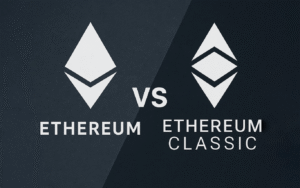
Ethereum vs Ethereum Classic
Classic debate has been an enduring theme in cryptocurrency, rooted in one of the most significant moments in blockchain history. The two projects share a common genesis, but diverged in purpose, core tech, and community following. The split between Ethereum and Ethereum Classic is essential to understanding how blockchain projects can split following fundamental disagreements.
This article describes what each network is and how they were created, what distinguishing differences in their technical and philosophical orientation there are, and what function they serve in today’s overall crypto space.
Origins of the Split: The DAO Hack
To grasp Ethereum vs Ethereum Classic, we have to revisit 2016 and the infamous DAO hack. The DAO (Decentralized Autonomous Organization) was among the earliest big attempts at decentralized funding on Ethereum and raised approximately $150 million in ETH at the time. An attacker, though, was enabled by a bug in the smart contract to drain about a third of the funds.
This angered the Ethereum community. Stakeholders and developers had to make the tough decision of whether to let it stand or act.
There was much deliberation, and there was finally an overwhelming vote to reverse the blockchain to prior to the attack. This undid the theft and restored funds. But there were those within the group who thought blockchains needed to be unchanging – that when data is added, it never gets altered, period. This group remained loyal to the original, untouched Ethereum chain, and it became Ethereum Classic (ETC).
Ethereum (ETH) persisted with the rollback under the Ethereum brand.
Name and Definition
There is a decentralized platform known as Ethereum, where programmers can create and deploy dApps and smart contracts. The platform was launched in 2015 by Vitalik Buterin and others as an initiative to take blockchain beyond basic payments such as Bitcoin.
Ethereum soon became the hub of innovation in DeFi, NFTs, and token creation. Ethereum established the ERC-20 standard of token, behind thousands of cryptocurrencies today.
In 2022, Ethereum shifted from proof-of-work (PoW) to proof-of-stake (PoS) consensus system in an event known as The Merge. This brought its energy consumption down drastically and altered block validation.
Market capitalization of Ethereum is now huge, supported by top developers, institutions, and firms building on top of its chain. It is now the second largest cryptocurrency by market capitalization.
What is Ethereum Classic?
Ethereum Classic refers to the original Ethereum chain that persisted rather than rolling back the DAO hack. Its adherents prioritize blockchain immutability above everything else.ethereum-schism-ethereum-classic Its proponents feel that, once transacted and validated, no transaction should ever be reversed, even at any cost.
ethereum classic continues to use proof-of-work and maintains Ethereum’s old tech. It has not implemented significant upgrades such as The Merge.
Though Ethereum Classic possesses less users and developer activity, it continues to be operational. Its purpose is centered around security, censorship resistance, and adherence to decentralization principles.
Philosophical differences
At the core of Ethereum vs Ethereum Classic lies a philosophical rift.
Ethereum is pragmatic. During theDAO hack, programmers decided to nullify the losses to safeguard users. Ethereum’s development, particularly its transition to proof-of-stake, demonstrates its adaptability and willingness to change to advance scalability and sustainability.
However, Ethereum Classic holds strong to the principle of immutability. Its followers feel that when you can rewrite a blockchain, then it is no longer trustless and decentralized. This stance supports consistency rather than flexibility.
These conflicting perspectives inform how every project updates its codebase, as well as its governance and interaction with the community.
Technical Development and Innovation
Ethereum’s development environment is much more lively. The Ethereum Foundation and numerous contributors spend endless hours making upgrades, applying security patches, and implementing technologies such as rollups and sharding to increase scalability.
The shift of Ethereum to proof-of-stake paved the way for Layer 2 solutions such as Arbitrum, Optimism, and zkSync, that lower costs and boost speeds for users.
Meanwhile, Ethereum Classic has a conservative development schedule. Its upgrades come less often and move at slower paces. ETC continues to use proof-of-work like Bitcoin. This attracts some of those miners who were driven out by Ethereum’s move to PoS.
Yet, absence of rapid development constrains Ethereum Classic’s popularity among dApp developers as they prefer to have access to the broader array of tools and ecosystem of Ethereum.
Security and Network Attacks
Security has proven to be an issue for Ethereum Classic. The network has undergone several 51% attacks, whereby an entity takes control of more than half of the network’s mining power and can double-spend coins or reorganize blocks.
This is because it has a lower hashrate than Ethereum or Bitcoin and hence is more susceptible to attacks.
Ethereum’s transition to proof-of-stake moved away from these issues. Validators have economic incentive to behave honestly, and it’s more expensive to attack the network than it is to gain any reward.
The consensus mechanisms used in different networks have implications for energy consumption as well. Ethereum Classic, like Bitcoin, uses higher electricity because of mining, whereas Ethereum has significantly reduced energy consumption since the Merge.
Community and Ecosystem
There is a big, diverse, and vibrant community of Ethereum. Ethereum is popular among developers, entrepreneurs, researchers, and investors. Uniswap, Aave, and OpenSea, some of the biggest protocols, are all built on Ethereum.
The Ethereum developer community remains one of crypto’s most vibrant with persistent innovation around scaling, privacy, and interoperability.
The community of Ethereum Classic is niche and smaller. People who prioritize decentralization and immutability over everything else tend to use Ethereum Classic. Although there have been some dApps and developers that have tried out ETC, there is no momentum and funding like that of Ethereum.
The above notwithstanding, Ethereum Classic exists as a philosophical counterpoint reminding the cryptocurrency world of its ideals as they were.
Market Performance and Tokenomics
It is among the most widely used and traded cryptocurrencies. It’s extremely liquid, exchanged as widely as possible, and incorporated in thousands of smart contracts. With increased adoption of staking, users can now earn passive returns by securing the network.
ETC is traded on large exchanges and enjoys a devoted investor following, but it does not share the same utility. The majority of DeFi apps and NFT platforms aren’t constructed on Ethereum Classic.
Both ETC and ETH operate with a limited supply inflation model, and Ethereum’s monetary policy has turned deflationary since The Merge. Ethereum burns part of its fee as it decreases overall supply.
Ethereum Classic doesn’t burn fees and has a more traditional issuance schedule.
Future Outlook
Ethereum is still moving full-steam ahead with scalability advancements and rising adoption. New projects are emerging around it, and institutions are still keenly interested. The Ethereum roadmap consists of enhancements such as danksharding and enhanced Layer 2 integration.
Though slower in development, Ethereum Classic can continue to be viable as a proof-of-work option. It can be used as fallback or “fail-safe” to Ethereum code and values, particularly in case of future ideological changes. As such, ETC’s development relies significantly on how well it can draw in developers and fend off attacks.
Ethereum versus Ethereum Classic isn’t just about two blockchains – it’s about two visions of what a blockchain is and can be. Ethereum is about flexibility, development, and applicability to everyday life. Ethereum Classic is about principle, consistency, and unalteredness. They both have their place in the crypto space, and knowing how they differ enables users and programmers to determine which best suits their intentions. If you prioritize performance and innovation, or security and traditional blockchain principles, both Ethereum and Ethereum Classic speak to your preferences regarding what you desire in the world of decentralization.














 Twitter
Twitter
 Telegram
Telegram
